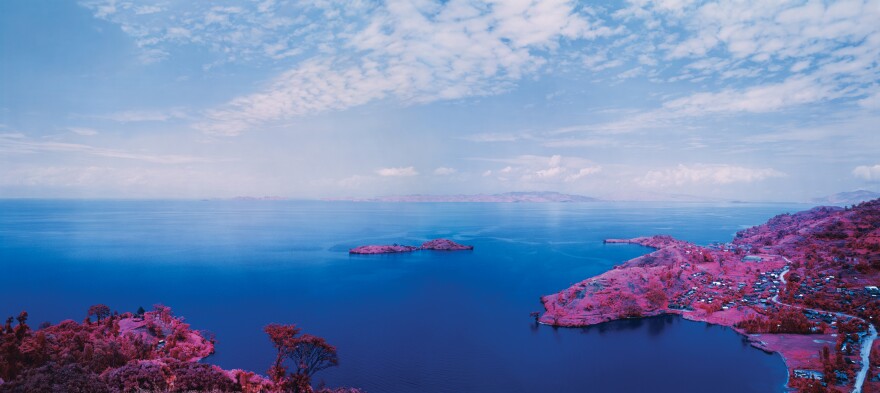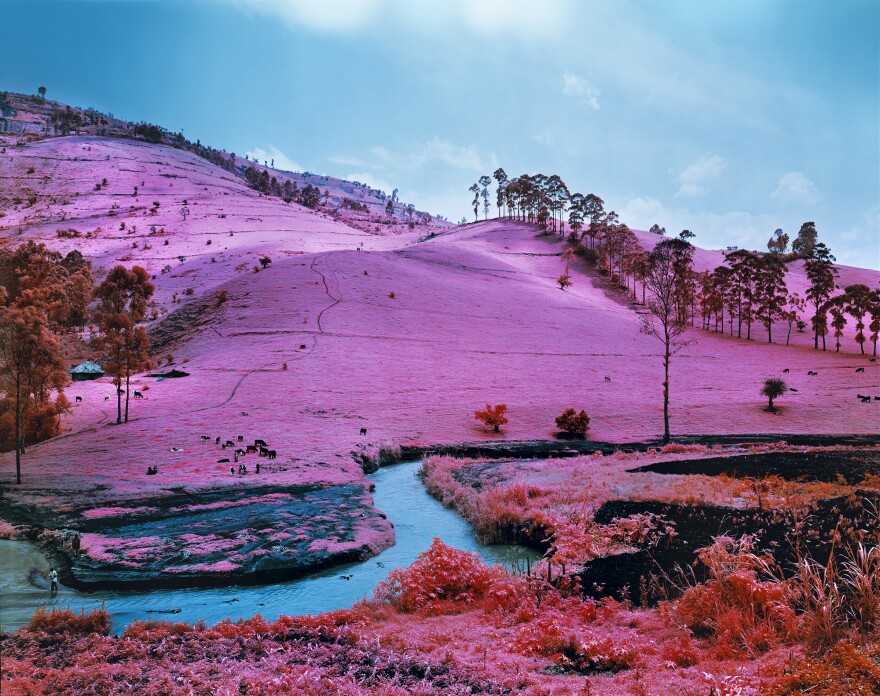At an exhibit at the Dayton Art Institute, it’s easy to pick out which of the stunning, large-format photographs belong to Richard Mosse. The Irish artist is one of two photographers featured in an exhibition at the Dayton Art Institute that ends this Sunday called “Ravage Sublime: Landscape Photography in the 21st Century.”
Richard Mosse’s images of the ongoing conflict in the Democratic Republic of The Congo are shot on film which is no longer made. In the past, it was used to make the psychedelic art work of the ‘60’s, and for US military reconnaissance purposes in Vietnam.
In Mosse's work, the African countryside has been transformed into a magical, pink landscape. Congolese fighters strike menacing poses against candy pink backgrounds, creating a powerful contrast between the beauty of the landscape and the menacing armed figures in the photo.
"Because it’s quite an eccentric way of describing the world when you photograph with this film," says Mosse. "It portrays the landscape in such vivid hues of pink and magenta. Scarlet, deep red, blood red. So it’s quite an aggressive palette, that really, it’s like drugs to the eyes sometimes. It really forces the viewer to look."

Photographer Richard Mosse uses a discontinued, infrared film called Aerochrome; used for military spying by detecting camouflage netting in the landscape. The film does this by picking up the infrared color spectrum of chlorophyll in living plant tissue.
The cheerful colors of the infrared-enhanced landscape contrast sharply with the brutality of the subject matter, which is the ongoing conflict in the D.R.C. The film renders the camouflaged uniforms of soldiers muted shades of black and grey, which stand out against the hot-pink landscapes.
"This Kodak Aerochrome infrared film, which was originally designed to detect camouflage installations, you have to remember that it’s able to see the unseen, it sees into an invisible spectrum of light," he says. "And so I guess I wanted to take that to represent this conflict, a very overlooked conflict in the heart of Africa, that’s really quite a terrible series of vicious little wars. 5.4 million people have died according to one statistic, since 1998, and that’s a lot of people, but you don’t really hear about it, generally. I wanted to try to make that more visible."
In the gallery adjacent to the auditorium, museum patrons Carla Huber and John Emory are looking at Mosse’s photographs.
"You know, seeing these, yeah, very surrealistic, beautiful landscapes with the relationship to war and destruction, think about the issues that he is exploring and that relationship between art and documentary," says Huber.
"It makes you feel really uncomfortable, which is really good, that ability to make you feel really uncomfortable, but you can’t turn away from them," says Emory.
"That’s all part of the work really, to force the viewer into this very uncomfortable space, where they're feeling seduced by this aesthetic pleasure, this beauty," says Moss. "Which by the way, the Congo is deeply beautiful place. And then they're trapped because they're like, ‘but I’m actually regarding the pain of others'. You know, human suffering."
Last summer Richard Mosse went back to the Congo and held a public exhibition of all his work from this series in the town of Goma, in the Eastern Congo. The installation drew mixed reactions from the locals, many of whom were featured in the work.
"Cause a lot of people asked me, 'That was amazing Mr. Richard, but why the hell did you make that?’. But a lot of people were moved by the piece. Like I had a real salt of the earth moto-taxi driver who had been shot three times a child, and he showed me his bullet wounds. He’s like ‘this film reminds me of that’. I think all art should be about making a dialogue, asking questions rather than making people feel comfortable, you know? If it’s not troubling, there’s nothing at stake. And when people get fired up and get pissed off with art, that’s sometimes a very good thing."
“Ravage Sublime: Landscape Photography in the 21st Century” is currently on exhibit through this Sunday, January 8th, at the Dayton Art Institute. The exhibit features large-scale, landscape photographs by Richard Mosse and Edward Burtynsky.






